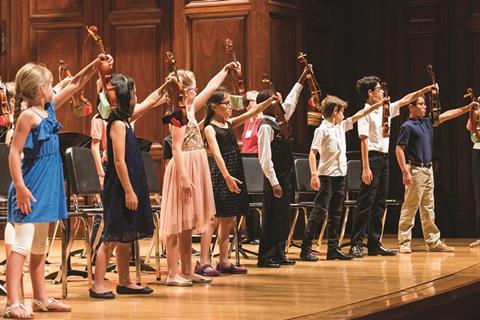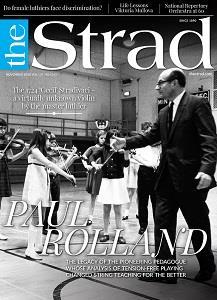Nancy Kredel describes some of the simpler actions devised by pioneering pedagogue Paul Rolland, our November 2018 issue cover star

Rest Position and Statue of Liberty (for violin and viola)
The student stands with the instrument held under the right arm, guitar style, with the scroll pointed slightly up towards the ceiling. The left hand is in the middle position. With the left pinky, strum all four strings.
Put feet together, then simultaneously move the left foot sideways and raise the instrument like a torch. The weight goes mostly to the left foot. The feet are a few inches apart and the left foot is slightly in front. Place the instrument in playing position. Transfer the instrument back and forth from torch position to playing position.
Flying Pizzicato
With the feet slightly apart and the instrument in playing position, put the left hand in the middle position with fingers floating over the strings. Get set to play a right-hand pizzicato near the end of the fingerboard. Pluck an open string with energy, casting the hand slightly forward and out, simultaneously allowing most of the body weight to go to the left foot.
The motion mimics a whole bow stroke with the arm going almost straight as it circles back to the fingerboard. As the arm comes back to the string, the weight returns to both feet.
-
Read: Who was Paul Rolland?
Roll the Arm and Rock the Bow

Put the left hand in the middle position with the fingers floating above the strings. Hook the tip of the bow on the left-hand pinky and make a good bow hold. Roll the right arm, moving the arm, hand and bow as a unit from the shoulder joint. Rock (shake) the bow gently as if sprinkling water or using a salt shaker.
Both actions can be done with the bow on the string also. Paul Rolland first saw this Roll the Arm action demonstrated by Dr Walter Haderer of San Francisco State College.
Rebound Stroke
Here you play a short open-string note near the frog, and then make a big circle with the bow, coming back to the frog. Gradually, the bow strokes are lengthened until you are using the whole bow, but always the motions are large and generous.
Rolland was very big on bilateral motion, where you start at the frog and, as you move towards the tip, your weight shifts slightly to the left, so that the motion of your bow arm is balanced, making the tone freer.
To read the full article in The Strad’s November 2018 issue, download the magazine now on desktop computer or via the The Strad App, or buy the print edition
Read another extract here: Paul Rolland’s tension-free philosophy










































No comments yet